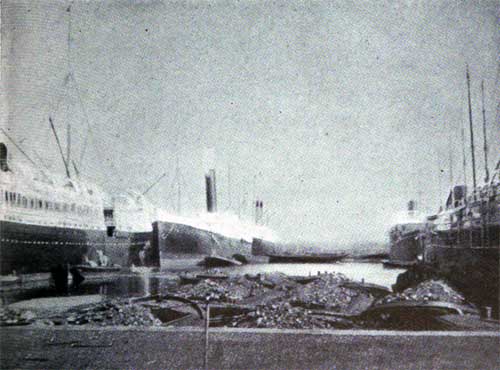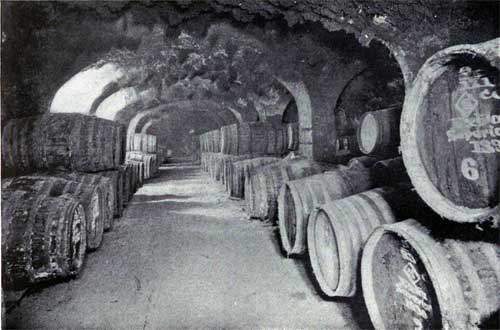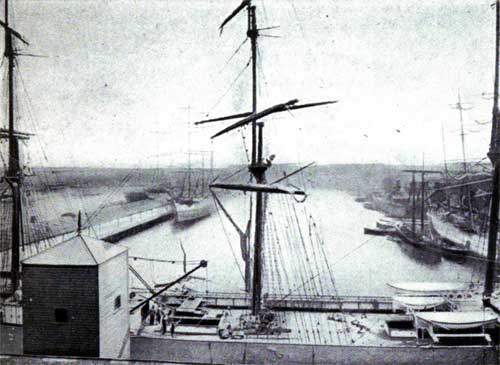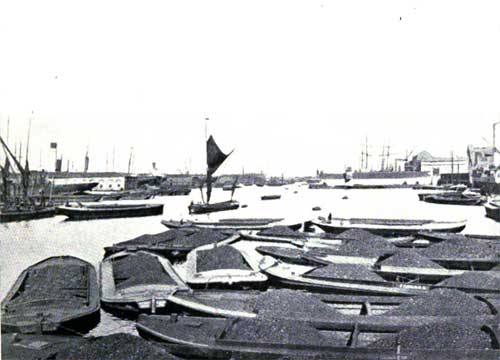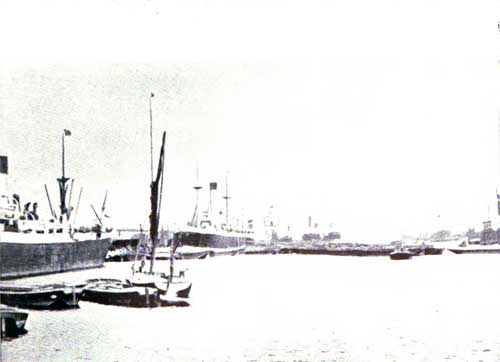Port of London, England
Tillbury Docks at the Port of London.
The Port of London consists of the river Thames from the sea to the outskirts of the Metropolis, with enormous areas devoted to various docks, besides Wharves, warehouses, and factories which line the river for mile on mile.
The Port of London (1921)
The glory of London is the Thames, without which it would be shorn of one of its most striking features. Pictorially, perhaps the Port of London does not present such natural beauties as are illustrated elsewhere in this volume.
The Port of London consists of the river Thames from the sea to the outskirts of the Metropolis, with enormous areas devoted to various docks, besides Wharves, warehouses, and factories which line the river for mile on mile.
With the exception of such institutions as Greenwich Hospital, the Tower of London, St. Paul's Cathedral, the Houses of Parliament, Westminster Abbey, and St. Thomas' Hospital, the buildings in the immediate vicinity of the river banks are almost entirely commercial and industrial in character, but anyone who has come up from the sea as far as London Bridge cannot fail to be impressed with the size and variety of the ships and craft which lie in the river and docks.
The history of the Port of London affords a fascinating study, and much has been written to explain the reasons for its pre-eminence.
Its geographical position has always counted for much; but perhaps the best explanation is that given in a brochure which has been issued by the Port of London Authority, under whose unified management the natural advantages of the Port and River have been consolidated and developed.
Although situated inland, its access from the sea made London from the earliest times a famous trading center, to which all roads led, and from which all roads started.
As time progressed, however, other seaports grew up as distributors for areas far removed from London. But then came the railways, placing the London market in direct relation with cities in the area of the rival ports, and all the kingdom found that by means of the iron road London was now its best and cheapest market.
The buyer's resort to it from all parts because of its vast variety of goods and the competition of the sellers. The sellers send their goods to it because it is the chief center for the buyers. You may create a port-the railways have created many, and will doubtless create more-but a market, who can create a market?
Directly or indirectly the great mart's influence is felt throughout the world, and everywhere its facilities for distribution are acknowledged.
As a home market it stands unrivalled. In some directions, London has regained during the war much of the trade which it had lost through continental competition.
The total net tonnage of Vessels which arrived in and departed from the Port of London with cargoes and in ballast from and to foreign countries and British possessions and Coastwise during the year ended 31st December, 1918, was 14,564,008 as compared with 37,154,133 in 1913, but these figures do not include the tonnage of many of the vessels engaged on Government service in connection with the war.
The value of total imports and exports (other than Coastwise goods) dealt with in London was £541,905,302 in 1918, an increase of 7.1 percent on the figures of 1917, as compared with an increase of 11.3 percent on those for the six principal ports of the United Kingdom for the same period.
Under the Port of London Authority, which took over the Port and Docks in 1909, great improvements have been made, and just prior to the war a scheme of port development involving a cost of £14,000,000 was projected.
Notwithstanding all the disadvantages occasioned by war conditions, various works at the London and St. Katherine Docks, West India Docks, the Surrey Commercial Docks, the Royal Victoria and Albert Docks, Tilbury Docks and other establishments of the Port of London Authority have been already completed or are under construction, and £7,760,000 has already been expended; additional works have been authorized to the amount of £3,835,000. When completed this work will assure the future of the Port of London for many years to come.
Paddington Station - London, England (1913)
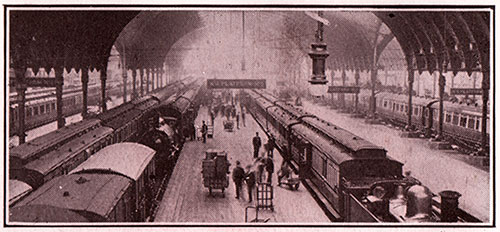
THE G.W.R. LONDON TERMINUS.
SPACE allows of nothing beyond the briefest mention of Paddington Station, the London terminus of the Great Western Railway, and one of the finest railway stations in London. It is the London gate to Windsor Castle, through which all the crowned heads of Europe have passed in turn, and it is the starting point for the beautiful West of England, the Shakespeare Country, and many another famous holiday haunt.
The station was designed by the great engineer, Isambard Kingdom Brunel, and was completed in 1854. The main design remains, but of course, many improvements from time to time have served to keep Paddington up to date.
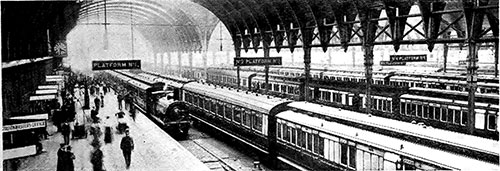
Paddington Station Platform 1. GGA Image ID # 1445650b19
Many conveniences for passengers may be found at Paddington. An Inquiry Bureau is installed in the Main Booking Hall, at which any information can be obtained upon the subject of home travel. Luxurious hot and cold baths and hair-dressing saloon have been provided for gentlemen on No. 1 platform.
Refreshments may be obtained at the Refreshment and Dining Rooms, the catering being under the direct control of the G.W.R. Hotels Management. Upon several platforms there are bookstalls (to which a circulating library is attached), where newspapers and periodicals, as well as works of fiction, &c., may he obtained. Supplies of smoking materials, chocolates, etc., will be found at the kiosk on No. 1 platform.
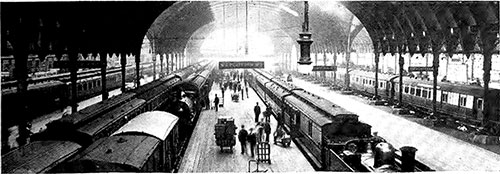
Paddington Station, Platforms 2-7. GGA Image ID # 1445666cda
Public telephones are installed in various parts of the station and telegrams may be forwarded from the telegraph offices on No. 1 and No. 8 platforms. A post office box will be found on No. 8 platform, and another on the departure platform, near the [main booking hall.
Letters may be posted for many parts of the country up to a late hour, in the late-fee box, which is near the latter. Insurances may be effected at the booking office in connection with the purchase of tickets and American, Canadian, French or German money can be exchanged at the usual rates of exchange at the same office. Passengers may find the number of the platform from which their trains start, at a glance, by reference to the notice boards, in all parts of the station.
It is an easy matter to get between any part of London and Paddington Station; apart from the numerous taxi-cabs, hansoms and hotel conveyances which may be found alongside the arrival platforms, 'buses run to all parts.
There are covered ways to Praed Street Station (subway) and, to Bishops Road Station (overhead way), both on the Under- ground Railway, which connects with most of the tube railways, and a few minutes' walk , through Spring St., leads to Lancaster Gate Station, Central London Railway.
The Port and Docks of London (1909)
The Docks of London are so spread out along the Thames River for a distance of 26 miles from London Bridge that they impress one as being disconnected, unco-ordinated and poorly managed in comparison with those of Liverpool, Antwerp, Rotterdam and Hamburg. London has so long been the leading port of the world in respect to the amount of shipping and goods which enter, that only within the last decade has the keen rivalry and phenomenal growth of some of the younger continental ports impressed her with the great importance of keeping abreast of modem requirements by providing better facilities for navigation.
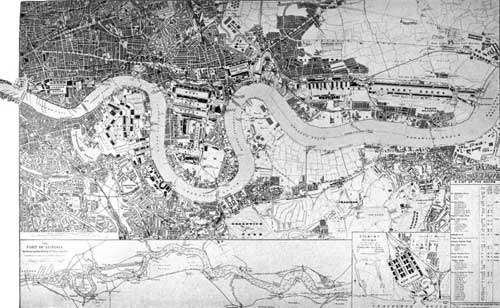
Plan of the Thames River and Lond Docks (1909)
The Royal Commission appointed to investigate this subject· speaks in its 1902 report of the natural advantages of the Port of London as being the "geographical position of the port; the magnitude, wealth and energy of the population behind it; the fine approach from the sea; the
river tides strong enough to transport traffic easily to all parts, yet not so violent as to make navigation difficult, and land along the shores of a character suitable for dock construction and all commercial purposes.
The existence upon the Thames of the greatest market and centre of consumption in the world, it is contended, bestowed upon the port a huge practical monopoly. London was sure of a trade of which rivals could not deprive it, and, in consequence, had not the usual incentives to affect improvements. Other ports in keen competition with each other for the general world-trade, have improved their organization and physical advantages in recent years, while London has in these respects remained much more nearly stationary.
Hence, it is suggested, both the inland and re-export trade of London may have lost ground, relatively to other ports, in consequence of the improvements in other maritime cities of the United Kingdom and in adjacent countries. So far as relates to the reexport of foreign and colonial produce the figures seem, to some extent, to correspond with this view."
Mr. D. Owen attributes the failure of the Port of London to maintain its rate of growth as a distribution port to causes of a wider character, as follows:
''Formerly London was a distributing and collecting port, as being the world's trade focus, the world's market. The cargoes came to the biggest market. The Low Countries and the Continent bought in London and sent goods to London for shipment. London was the 'Goods Exchange' for Europe to a large extent. Foreign produce formerly was largely a prohibitive luxury, only available to the few.
Foreign ports had no use for shiploads; they wanted parcels; shiploads came to London. The development of production, cheapening of transport, abolition
of duties, increase of population, spread of wealth, and the introduction of steam factories, altered the situation.
The Continent became able to swallow whole shiploads, but Continental ports being undeveloped and unhandy, and the force of ancient usage being strong, cargoes continued to come to London.
In 1863 the abolition of the ScheIdt dues threw open Antwerp, which at once began to compete with London. The Suez Canal was opened, trade increased enormously, and ships began to be ordered, with full cargoes, to Antwerp.
The new departure extended to Hamburg, Rotterdam, Havre, and other places, and all these ports began competing furiously with one another, and all with London. Moreover, the practically new ports of Marseilles, Genoa, and Trieste now intercept cargo which formerly passed through the Straits of Dover, and these ports are greatly developing.
This competition, powerful as it is, is still in its infancy. Continental ports are spending lavishly on improvements, and already British ship-owners prefer Antwerp to London, and would as soon go even to Hamburg as to London. It seems inevitable that the business of London as a port of distribution will decline."
With all the natural advantages, and the fact that London is Lhe greatest city in the world with a population of 7,000,000 and growing rapidly, the increase in the commerce of the port is much less than the increase in population and less than the increase in commerce of the ports of New York, Antwerp and Hamburg.
This is more especially due, first, to the fact that London, previous to 1909, had no centralized authority to administer the affairs of her great port with that singleness of purpose, so conspicuous in the work of "The Mersey Docks and Harbour Board" of Liverpool, and the "Oyde Trustees" of Glasgow,--and secondly, to the fact that the ownership, maintenance and management of the quays and docks was so divided between many different individuals and corporations, that it was almost impossible to obtain that unity of action so important to the development of a great port Previous to 1909 there were no less than five controlling authorities on the River Thames.
DOCKS.
In addition to the control of the waterway the Port of London Authority own and manage the Docks, formerly vested in the London and India, Surrey Commercial, and MillwaU Dock Companies, whose land and water areas consisted of 2,467 acres. There are also 10 acres of city properties and 106 acres of land at Crossness, making a total area of 2,583 acres.
The river frontage of the dock properties is about 3 miles in length. There are 28 miles of dock quays available for shipping. The machinery employed at the Docks is worked principally by hydraulic power, but electricity has been introduced during recent years. There are 1,468 cranes and lifts of varying capacity, including sheer legs lifting up to 80 tons, and 5 floating derricks lifting from 15 to 50 tons at wide radius. Amongst the movable plant are 23 tugs and 42 locomotives for use in and about the docks and railways. There are about 120 miles of
railways.
The purchase price of the three Dock undertakings was paid by the issue of Port Stock in substitution for the various Dock stocks, the amounts given being:
- 3% "A" Stock : $44,479,459
- 4% "B" Stock : $64,204,605
- Total : $108,684,064
The following describes briefly the individual docks and equipment:
Port of London, St. Katharine Dock (1909)
This Dock adjoins the Tower of London and is within a few minutes walk of Fenchurch Street, Aldgate, and Mark Lane Stations. The northern railway companies have goods stations within a few yards of the Dock, and the Tower Bridge provides a short route to the goods stations on the southern railways.
The area of the Dock is 23 acres-l0 acres being water space.
The entrance lock is 180 feet long by 45 feet wide, with a depth at high water spring tides of 28 feet on the outer sill and 24 feet on the inner one.
The Dock is accessible only to vessels of moderate size-such as those trading in the Coasting and Continental services.
The storage capac.ity of sheds and warehouses is equivalent to 86,000 tons, and in addition the wine and oil vaults have a capacity of 37,500 pipes.
There are 68 hydraulic cranes and other lifting machinery.
Port of London, London Dock (1909)
This system adjoins the St. Katharine Dock and occupies 100 acres, 40 of which are water. The storage capacity of sheds and warehouses is 174,000 tons, and there are wine, spirit, and oil storage vaults of 105,000 pipe capacity. The machinery includes 132 hydraulic and other cranes (one of 25 tons lifting power).
Wine Vaults, London Docks. Capacity Over 8 Million Gallons
There are four entrance locks, three being in use and one closed:
| Entrance Locks | Length (ft.) | Width (ft.) | Depth (ft.) | Remarks |
|---|---|---|---|---|
| Wapping | 170 | 40 | 23 | at High Water Spring Tides. |
| Shadwell (Old) | 180 | 45 | 24 | |
| Shadwell (New) | 350 | 60 | 28 | |
| Hernritage (Closed) | 150 | 40 | 21.5 |
By means of pumps the water in the Dock is continuously maintained at a level of 3 feet 6 inches above Trinity High Water Mark.
This Dock is available for vessels up to 4,500 tons.
The Western Dock -- London Docks
Wool is shown and stored, and about 700,000 bales pass through the dock warehouses annually. The accommodation provided for the wool business in the London and St. Katharine Docks has a floor area of 1,400,000 feet. The imports into London annually are about 1,600,000 bales, weighing 250,000 tons, and of an estimated value of $97,200,000.
Wines and spirits. The principal wines stored are port, sherry, and madeira. The brandy vaults cover an area of four acres. In connection with the wine and spirit business there are 46 vats, capable of holding 102,000 gallons, which are used for blending purposes.
In the bottling department some 125,000 dozen bottles are filled and packed yearly.
Port of London, Surrey Commercial Docks (1909)
These docks are situated on the south or Surrey side of the Thames (at Rotherhithe), about 1 1/2 miles from the Tower Bridge. The system covers an area of 451 acres, and includes the Surrey Canal, which extends from the Docks to Camberwell, is upwards of four miles in length, and has an area of 70 acres.
In addition to the deep water area of 103 acres there are ponds for the storage of timber covering 63 acres.
There are four entrance locks, viz.:
| Entrance Lock | Length ft. | Width ft. | Depth ft. | Remarks |
|---|---|---|---|---|
| Greenland Lock | 550 | 80 | 33 | at High Water Spring Tides. |
| Surrey Lock | 250 | 50 | 27.25 | |
| South Lock | 220 | 48 | 27 | |
| Lavender Lock | 320 | 34 | 18.5 |
The Surrey Commercial Docks are the chief depot for the soft wood trade of London, as much as 780,000 loads being received for storage in the course of twelve months. The piling grounds are 200 acres in extent, and shedding of 48 acres has been provided for the storage of wood under cover, with a capacity of 233,000 loads.
The Dock Quays are 6 miles in 'length, and there are 8 miles of paved and macadamized roads.
The new Greenland Dock, the most recent addition to the system, was opened in 1904, and is 2,250 feet in length, 450 feet in breadth, the water area being 22 acres, with quayage upwards of a mile in length. The Dock will accommodate vessels of 10,000 tons.
In the Greenland Dock special provision has been made for the accommodation of Canadian produce in warehouses of a capacity of 2,000,000 cubic feet, providing cold air and cold storage. A large trade is also done in the storage of grain.
Port of London, West India Docks (1909)
These docks are situated on the northern part of the Isle of Dogs, Poplar. They are 231 acres in extent, 105 acres being water. They consist of three parallel sets of docks, each about half a mile long, viz,- The West India Import Dock, the West India Export Dock, and the South West India Dock, with four adjoining basins. The Poplar Dock, at the eastern end of the property, is leased to the North London Railway Company, and is used for the discharge of coal and other goods for transport by railway.
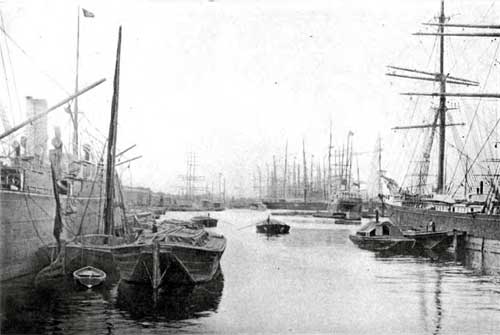
The West India Docks.
Area nearly 300 acres, large enough to contain at one time more than 4150 West India Merchantmen.
There are four entrance locks, two only being in use, viz.:
| Dock | Length ft | Width ft | Depth ft | Remarks |
|---|---|---|---|---|
| Blackwall | 480 | 60 | 30 | at High Water Spring Tides |
| South Dock | 480 | 55 | 29 | at High Water Spring Tides |
Vessels up to 7,000 tons can be received. The storage capacity of the warehouses is 195,000 tons, and that of the vaults 40,000 puncheons.
There is refrigerated accommodation for 114,000 carcasses of sheep.
There are four miles of quays for discharging.
Port of London, Millwall Dock (1909)
This dock is situated on the Isle of Dogs, and has an area of 233 1/2 acres, 35 1/2 acres of which are covered with water. The entrance lock in Limehouse Reach is 450 feet long, 80 feet wide, and 28 feet deep at high water spring tides, and vessels up to 9,000 tons are accommodated.
An important general trade is done with vessels from the Baltic, Northern and Southern Europe, and North and South America, but the special feature at Millwall Dock is the grain trade. About 9,000,000 quarters of grain are reported annually at the Customs for discharge in
the Docks of London.
About one-third of this quantity is discharged at the Mi!lwall Dock. The new Central Granary, 250 feet long by 100 feet wide, and consisting of 13 floors, has a floor storage area of 7 acres, and will accommodate about 120,000 quarters. Immediately in front of this granary, and on the quay side, are four nests of silos, with a storage capacity of 18,000 quarters, and on a dolphin running parallel with the quay is placed powerful pneumatic machinery for discharging the grain from the importing vessels.
Port of London, East India Dock (1909)
The East India Dock is situated about half a mile from the West India Dock. There are two entrances, viz:
| Dock | Length | Width | Depth | Remarks |
|---|---|---|---|---|
| ft. in. | ft. in. | ft. in. | ||
| The Western | 210-6 | 47-5 | 24-10 | at High Water Spring Tides |
| The Eastern | 100-0 | 65-0 | 31- 0 | at High Water Spring Tides |
Vessels of 8,000 tons burden can dock in the basin. The area of the dock is 71 acres, 33 acres being water.
The storage capacity of the warehouses equals 34,500 tons. There are 1 1/2 miles of quays.
The dock is principally used by the steamers of the Union-Castle Line.
The entrance to the Blackwall Tunnel is close to the main gate of the East India Dock. Opposite the Tunnel is the Poplar Hospital for Accidents-a hospital originally established, and still used, for the many cases of accident which arise at the docks and surrounding factories.
Port of London, Royal Victoria and Albert Docks (1909)
The Royal Victoria and Albert Docks, extending from Blackwall to Galleons Reach (a distance of 3 miles), are the largest under control of the Port of London Authority. The docks are reached by train from Fenchurch Street Station in about 15 minutes, the stations for the Victoria Dock being Custom House and Tidal Basin, and, for the Royal Albert Dock, Galleons, Manor Way, Central and Connaught Road.
Royal Victoria Dock, London. View from the Western End.
The water area consists of 182~ acres, the combined land and water area being 767 acres. These docks are within the London cartage radius. There are three entrances. The Victoria Dock entrance is in Bugsby's Reach. 325 feet long, 80 feet wide, and 28 feet deep at high water spring tides; and the Royal Albert Dock entrances are in Galleons Reach, viz:
- Galleons (Upper) 550 ft. long, 80 ft. wide, 30 ft. deep at High Water, Spring Tides.
- Galleons (Lower) 550 ft. long, 80 ft. wide, 36 ft. deep at High Water, Spring Tides.
Royal Albert Dock, London -- Looking Eastward.
Vessels up to 12,500 tons can dock here with every facility. The floor area of the sheds and warehouses is 71~ acres, with a storage capacity equivalent to 281,000 tons of goods. The cold 'storage warehouses in the Victoria Dock are capable of receiving 568,000 carcasses of sheep. The length of quays is 9 miles. There are 1M hydraulic and other cranes of varying calibre.
Port of London, Tilbury Dock (1909)
The Tilbury Dock, situate on the north side of the Thames, opposite Gravesend, is reached by the London, Tilbury & Southend Railway, in about 40 minutes from Fenchurch Street Station.
The Centre Branch Dock -- Tillbury Docs
1,600 Feet in Length and 300 Feet in Width
The system consists of a main dock with three branch docks, connected with a tidal basin by means of a lock 700 feet long and 80 feet wide, with three pairs of gates. The main dock is 1,800 feet long by 600 feet wide. Each branch dock is 1,600 feet long, the width of the centre one being 300 feet while the two outer ones have an average width of 250 feet. The total water area in the main and branch docks is 54 acres.
The basin is 17 1/2 acres in extent. The total area of the estate is 591 acres. The depth in the tidal basin at high water spring tides is 45 feet, and there is never less than 26 feet. In the main and branch docks the depth at spring tides is 38 feet. The largest vessels using the Port of London are accommodated at the Tilbury Dock, the entrance lock of which is of sufficient size to admit vessels of 25,000 tons.
The floor area of sheds and warehouses is 23 acres, and the storage capacity equals 83,000 tons of cargo. The quays are 2 1/4 miles in length.
The principal lines using this dock are the Peninsular & Oriental, Orient, Atlantic Transport, White Star, Qan, Anchor, and Bibby Lines. There is a daily service to Ostend, and twice a week to Hamburg.
The Tilbury Hotel, containing 100 bedrooms, is the property of the Port of London Authority.
Port of London Town Warehouses (1909)
Cutler Street Warehouses are the largest of the group, and are situated near Houndsditch and Bishopsgate Street. They occupy 5.5 acres of ground, and are provided for the reception of the more valuable classes of goods.
The principal articles stored are tea, Oriental carpets, chinaware and japanware, silk, silk and cotton piece-goods, ostrich feathers, fancy feathers and bird skins.
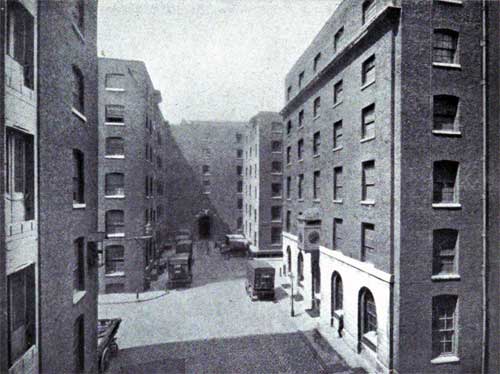
Cutler Street Warehouses, London -- Covering an Area of 5 1/2 Acres.
Crutched Friars Warehouse is situated in Crutched Friars, and is used for cigars, cigarettes, furs, drugs, and other articles of value.
Commercial Road Warehouse, situate at the City end of Commercial Road, is built over the Goods Depot of the London, Tilbury and Southend Railway, and was designed for the accommodation of traffic to and from the Tilbury Dock. All classes of goods are dealt with, the chief being Indian and Ceylon tea.
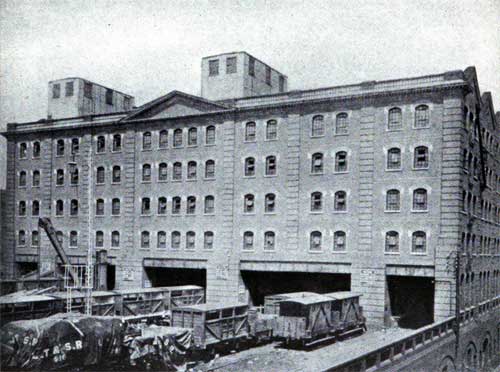
Commercial Road Warehouse.
Built over the Goods Depot of the London. Tilbury and Southend
Railway. and designed for traffic to and from the Tilbury Docks.
West Smithfield Cold Air Stores, in St. John Street, the more recently constructed of the Town Warehouses, is for the storage of refrigerated meat, etc. It adjoins the Smithfield Meat Market and provides occommodation for 100,000 carcasses of sheep.
Dry Docks of London (1909)
There are two in the Royal Albert Dock. (1) Length 501 feet, 85 feet wide at cope, 66 1-3 feet wide at entrance, 22 feet on sill at Trinity High Water. (2) Length 408~ feet, 77 feet wide at cope, 64~ feet wide at entrance, depth on sill 22 feet at Trinity High Water.
One at Millwall Dock, 450 feet long, 65 feet wide, and 20 feet over blocks at Trinity High Water.
Two at Tilbury Dock-the largest in the Port-each capable of being used either as a single dock, 850 feet long, or as separate docks of varying lengths, having a depth on sill of 35 and 30 feet respectively at Trinity High Water.
The two docks are 70 and 60 feet wide respectively.
The division of each set is made by means of caissons.
Bibliography
"London (The Port of London)," in Official Guide for Shippers and Travellers to the Principal Ports of the World, Osaka: Osaka Shosen Kaisha, 1920-1921, p.832-834.
Great Western Railway, "Paddington Station," in Season 1913 Holiday Haunts in England & Wales: The Official Guide to Holiday Resorts served by the G.W.R. with particulars of accommodation for holiday makers and travellers generally, London: Great Western Railway, 1913, p.15.
Frederick L. Ford "The Port of London (Including Docks)," in "Part II. A Study of Some Representative European Ports in the Summer of 1909", in the Report of Connecticut Rivers and Harbors Commission to the General Assembly, Hartford: State of Connecticut, 1911, p.36-47

